Modern kitchens can be equipped with high-tech household appliances, furnished with the most expensive fittings and furniture combinations. However, there is one thing that no kitchenette can do without. We are talking about a potholder with which you can pick up a hot saucepan from the hob or remove a baking sheet from a preheated oven. Ready-made Christmas potholders, sewn, as well as dedicated to other topics, can be bought at any home goods store. However, we propose to try yourself in this business and make do-it-yourself potholders from fabric with patterns. This article will focus on how to sew an oven mitt for beginners and hobbyists.

DIY potholders: materials, tools and skills
Sewing potholders with your own hands is not as difficult as it might seem at first glance. For crafting, you need inexpensive materials and a little creativity to make something new and original. In case you have no time to fantasize, there are many photos with ready-made templates on the Internet. Numerous videos are also designed to help you understand the process.
Attention! Earned on our website kitchen designer. You can familiarize yourself with it and design your dream kitchen for free! May also come in handy wardrobes designer.
Let's figure out what materials we need for the external design and internal filler, and also decide on the shape of the potholder.

External material
First of all, it is important to remember that you can choose material for external design only from natural fabrics. A double potholder made of synthetic fabric will instantly flash and ignite from contact with fire, and from excessive heat it will simply melt on your hand. Another disadvantage of synthetics is the toxicity of fibers in contact with food.
Among natural fabrics, give preference to the following:
- chintz - used to apply full-color drawings;
- linen is a dense fabric with a pronounced texture, consisting of dense threads. It does not slip on the surface and is pleasant to the touch. In order for the material not to wrinkle, it is possible to add synthetic threads to the composition (no more than 20%);
- cotton is a dense, high-quality and inexpensive material. Widely presented in a variety of colors and prints, there is plenty to choose from.
Internal filling
For the inner filler, as well as for the outer part, only natural and wear-resistant materials are selected. Most importantly, do not forget to print the patterns in the correct sizes. The patterns are always indicated more than the finished tack will come out as a result. The thing is that the material inside assumes the volume of the product.
The following options will be excellent filler materials:
- felt - felt tacks are the most common due to the strength, reliability and low cost of the material. The material is not afraid of high temperatures and is pleasant to the touch;
- wrap - the material has low thermal conductivity and high strength. Choose the option that is not the thickest in terms of thickness, as the needle of the machine simply will not "bite through" it;
- batting - it is important to be careful with potholders, the filler of which is made of batting. If the upper fabric cannot withstand the heat from a hot surface and breaks through, then the batting can also burn through. There is a risk of burns.
Note for those who want to decorate the finished potholder with elements that are looped or crocheted: opt for natural wool. This material is not only environmentally friendly and of high quality, but will also look great in any kitchen. It is advisable to choose the color of the wool from considerations so that it is combined with the shade of the kitchen curtains.
Tack shape
Before starting work, it is important to consider the shape and appearance of the potholder in general. The most important role in the choice is played by practical and functional points. The accessory should lie comfortably in the hand, comfortably grip hot kitchen utensils and just look stylish, lying on the kitchen countertop or hanging from a nail.
The most common and popular forms of potholders:
- square;
- a circle;
- mitten or mitten;
- an elongated rectangle;
- leaf, berry, fruit, heart and other creative shapes.
You can make an unusual potholder already at the moment of the shape by choosing the option of the heart or any other of the last paragraph. Or you can stay on a simple, concise form, but add originality with further decoration.
Interesting options for external design:
- application;
- crochet embroidery using a special pattern;
- crochet strapping;
- decorative seam.
If you are thinking about how to sew an oven mitt and how to arrange it, you don't have to worry, it's not difficult at all. The most important thing in this business is to follow the instructions and experience of those people who know a lot about their hobby. For them, this no longer arises such a question as to sew a mitten with an oven mitt. Perhaps you, having acquired knowledge and skill in this area, will become such a person.
DIY potholder: interesting ideas
Needlework is, in fact, a very useful and profitable hobby. Using just a few scraps of fabric, filler material and your limitless imagination, you are able to create unique masterpieces with your own hands. They can be left at home or presented as a gift to friends, relatives and family. And in such large cities as, for example, Moscow, it becomes a real idea to establish even your own small business on do-it-yourself production of potholders from shreds, transfer patterns to others, share experience and knowledge, launch master classes. All this can be achieved if you wish to develop in this area. But for now, we'll just learn how to properly sew an oven mitt at home.
Especially for you, we have prepared some interesting ideas for the manufacture and design of homemade pot holders.
Quilted
These tacks are the most popular. They are very common in both domestic and foreign cuisines. There is a reason for this popularity. The thing is that quilted household items make the interior of the room warmer, more homely and more comfortable. They are also easy to do with your own hands.
Patchwork
This type of product looks no less pretty in the kitchen, adding to the interior the same feeling of coziness and comfort as the quilted version. A tangible difference lies in the fact that the process of making patchwork kitchen potholders with your own hands, patterns and prints is much more complicated. You will need much more time, as well as a clear sewing pattern and the ability to cut the necessary parts.
Loop or crochet
Experimenting with hooks or eyelets will ensure the accessories are secured. Knitted potholders will create a special, colorful atmosphere in your kitchenette. Quirky products will give your home a zest and breathe new life into it.
For beginners, the easiest option would be to crochet dense, non-volumetric patterns. It is not difficult at all and does not require a lot of time and effort.
Summing up
We have told you the whole theoretical part. Now it's time to put the knowledge you gained into practice. We will tell you how to sew a beautiful mitten potholder:
- The first step is to create a pattern. To do this, take a regular A4 sheet, put your palm on it. Fold the sheet as if you are going to put on a mitten and trace the silhouette around the outline. Remember to step back 2-4 centimeters from the edges. At the end of this action, you will receive a pattern.
- Cut out the elements of the inner and outer material according to the resulting template. For the front part, choose a natural fabric that matches the color of your kitchen interior. If you are looking for something a little more interesting, you can purchase a bold fabric to make it stand out and serve as an accent color. For the inner filling, you also need a natural fabric that will be pleasant to the touch and soft.
- The next step is to process the filler. Cut two shreds of thick natural fabric according to the intended pattern.
- Fold the pieces as follows: Place two pieces of colored fabric, intended for the outside of the oven mitt, face to face on a flat surface. Next, attach the filler cuttings to the finished elements from above and below. Then lay a piece of interior fabric on both sides again.
- All parts should be fastened with pins so that they do not move while sewing.
- Sew the edges, 5-8 millimeters away from the edge.
- You got your mitten inside out. Before reaching the seam about 3 millimeters, trim off the excess fabric.
- Use scissors to make small cuts where the mitten is rounded. This will make it easier to turn the tack inside out with the right side up.
- Turn out the finished mitten, try to put it on, evaluate how comfortable it sits on your hand. If desired, decorate it with ribbons, buttons, braid or paint with fabric paints.
Now you know how and from what materials to make potholders of different shapes with your own hands. Experiment with patterns and shapes, create, fantasize. Happy needlework!
Photo: beautiful handmade kitchen potholders
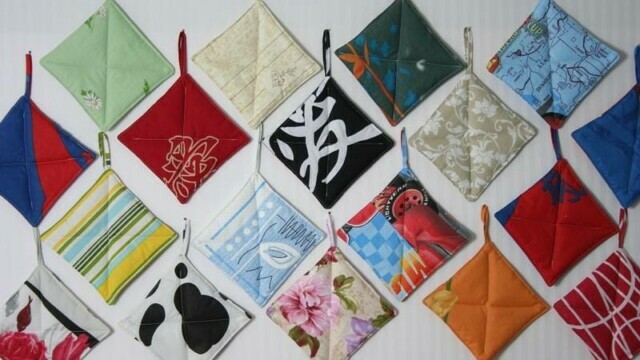
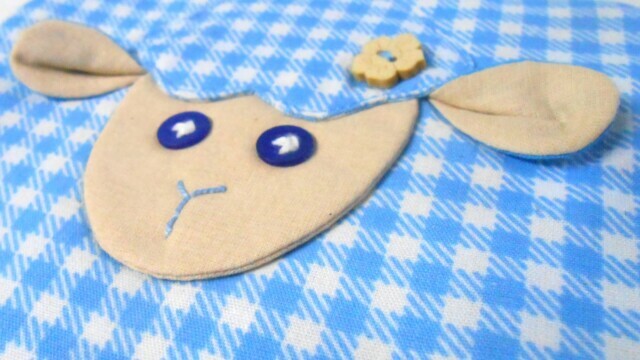

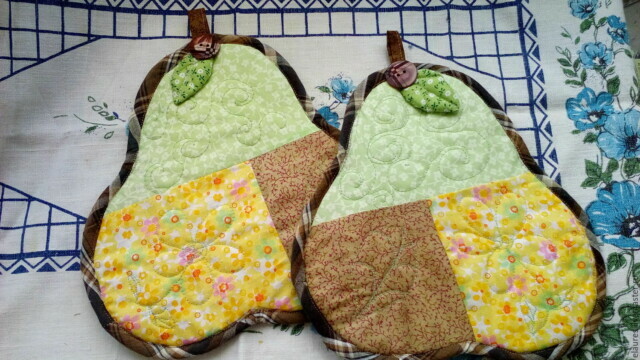
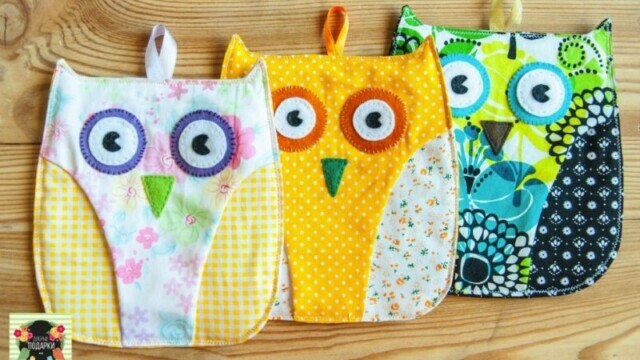
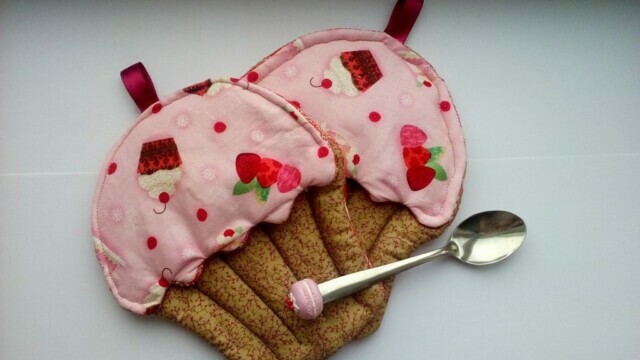
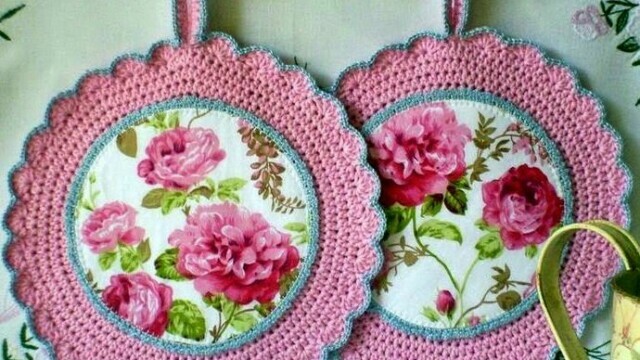

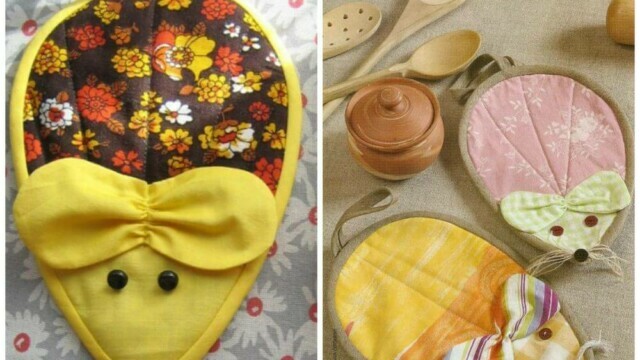
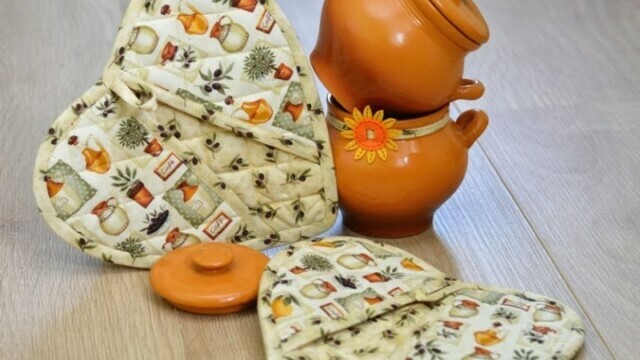
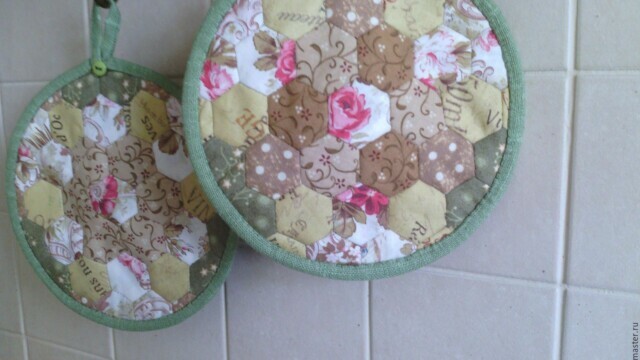
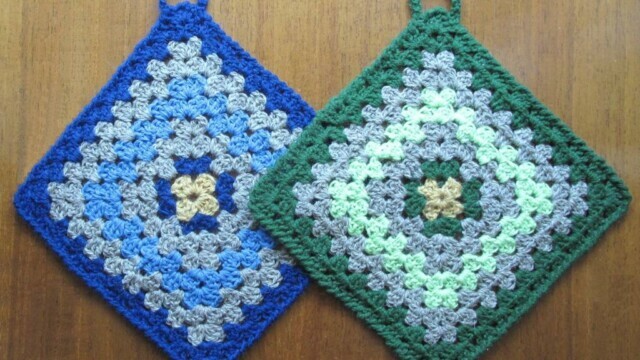
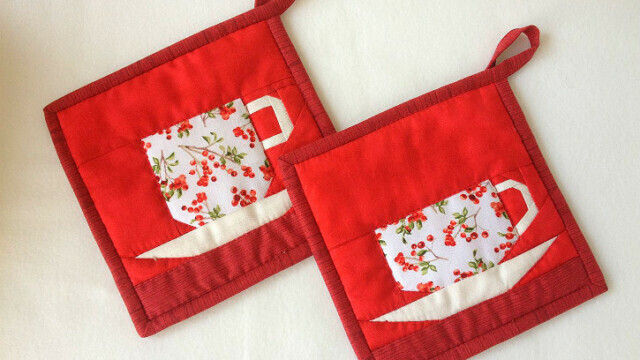
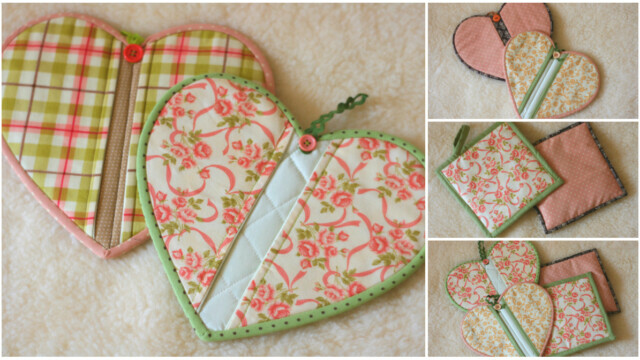
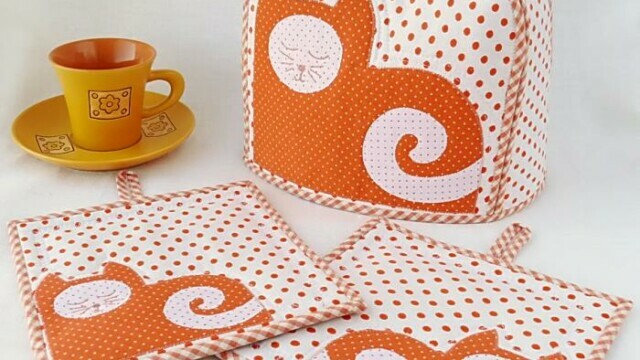
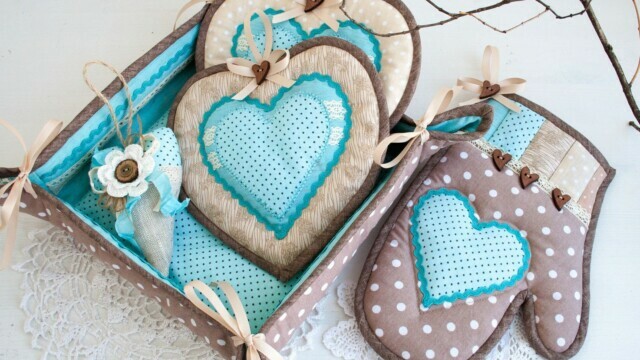
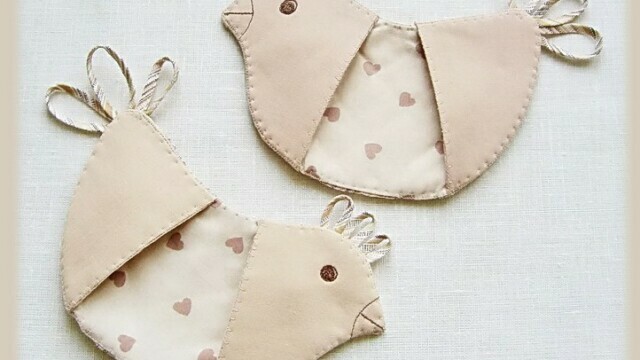
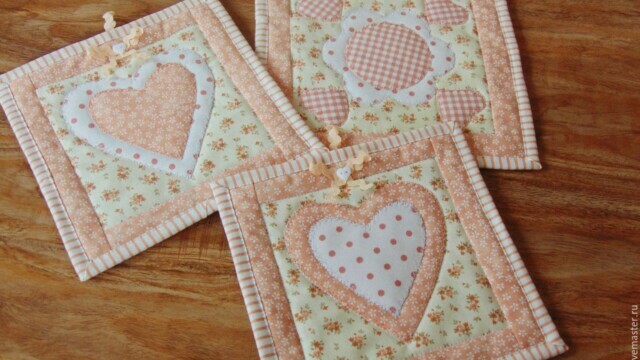
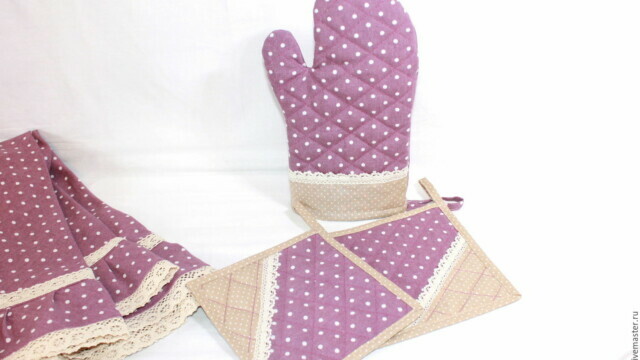
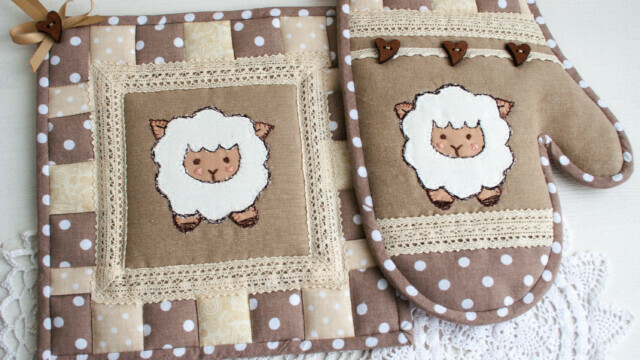

Prev
Next
average rating 0 / 5. Number of ratings: 0
No ratings yet. Be the first to rate.


